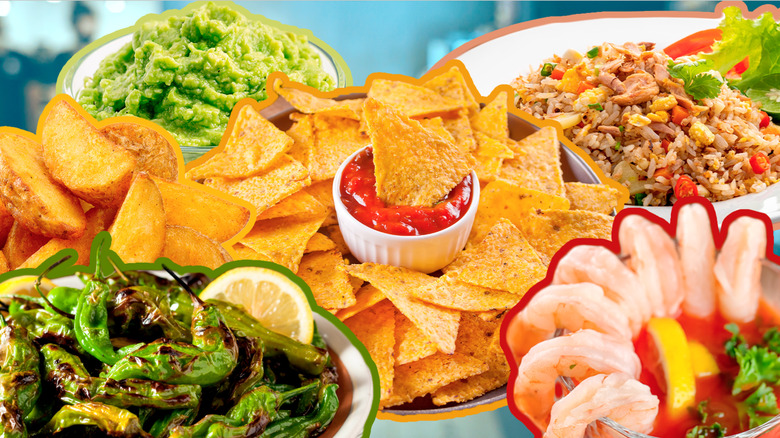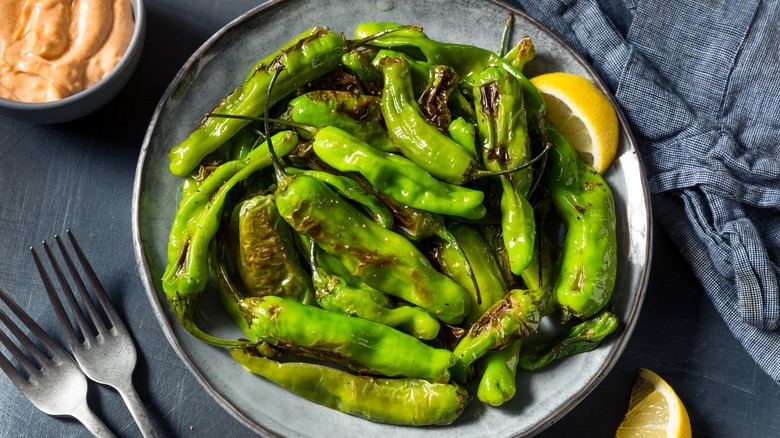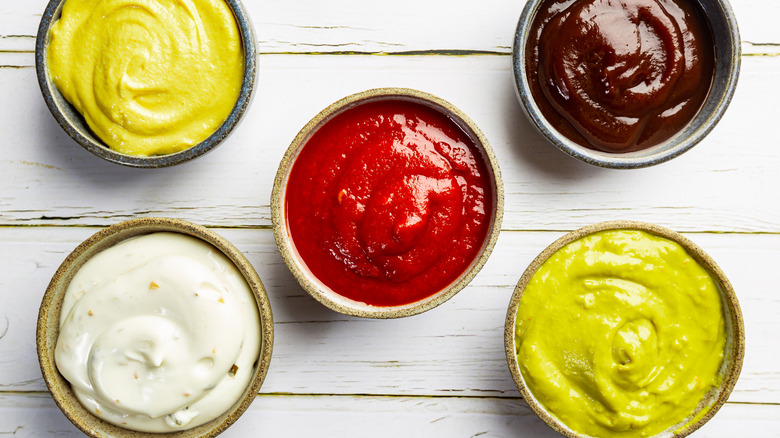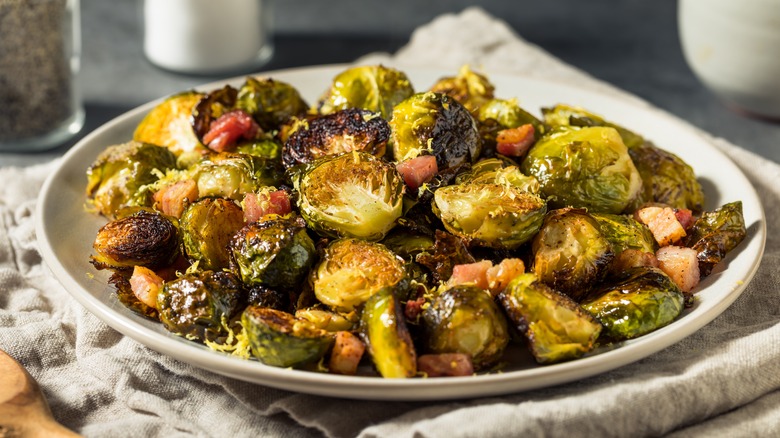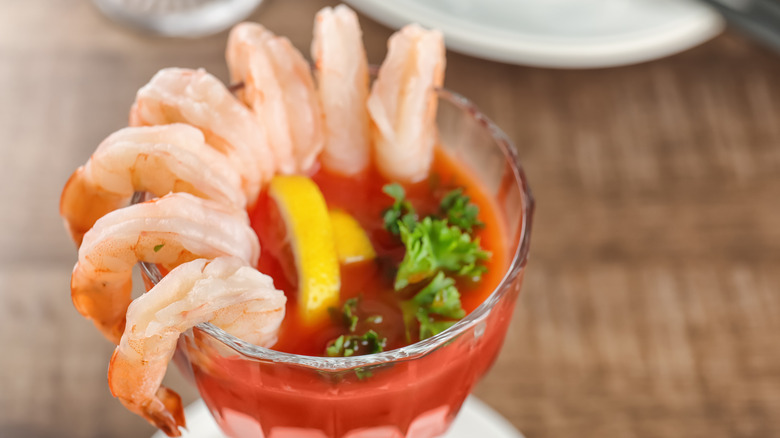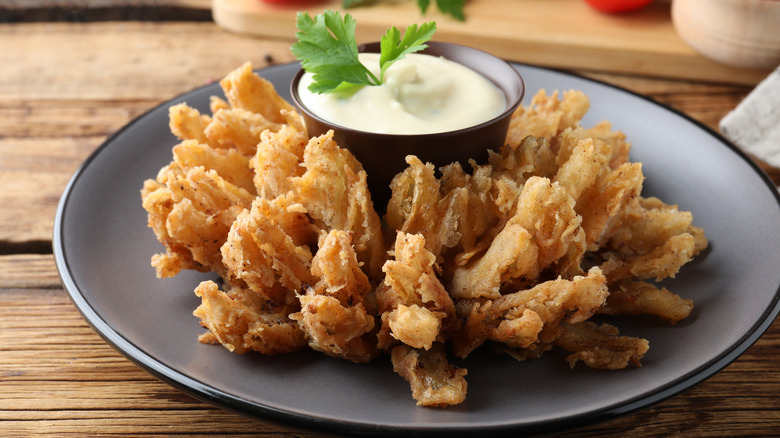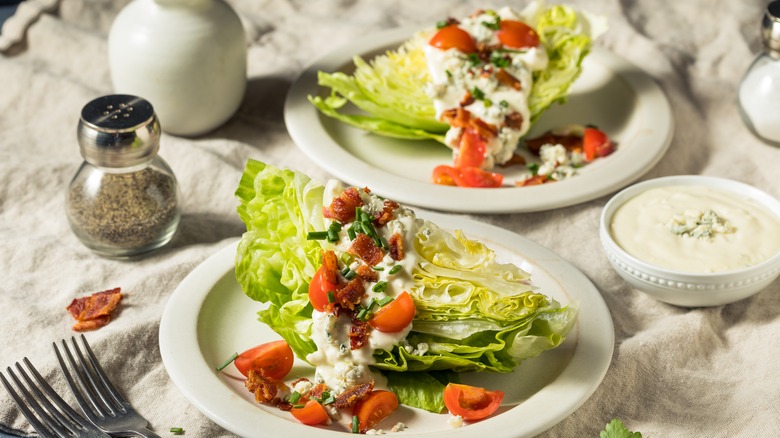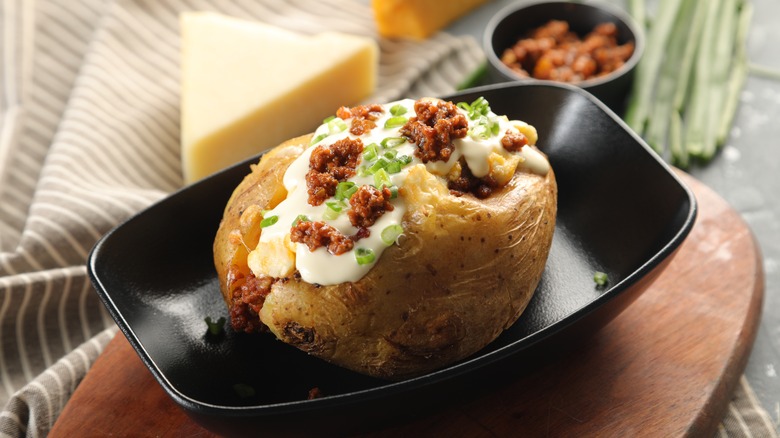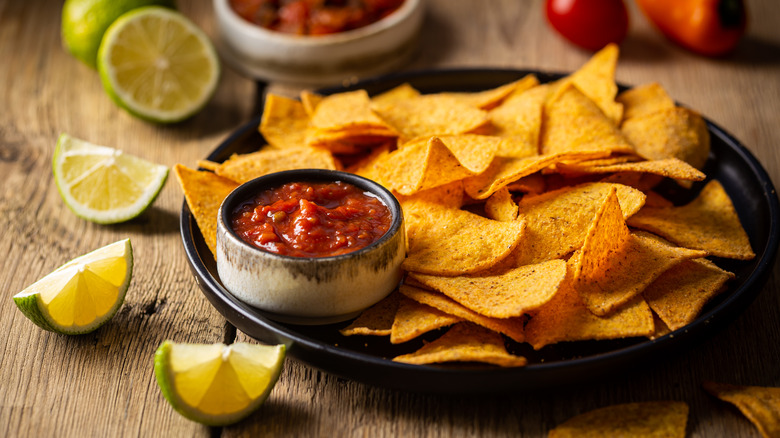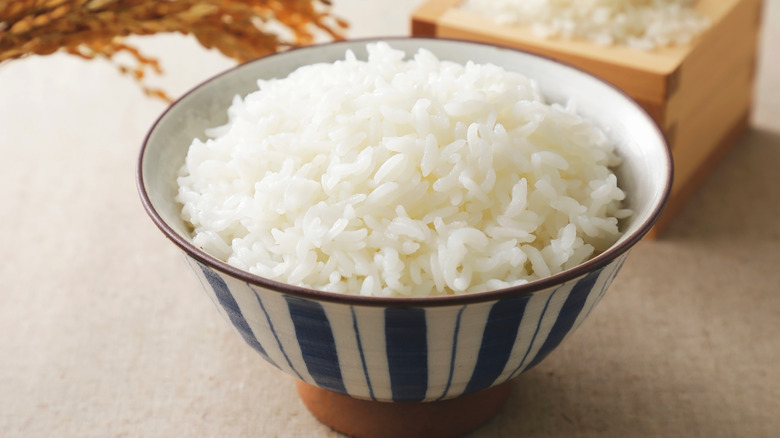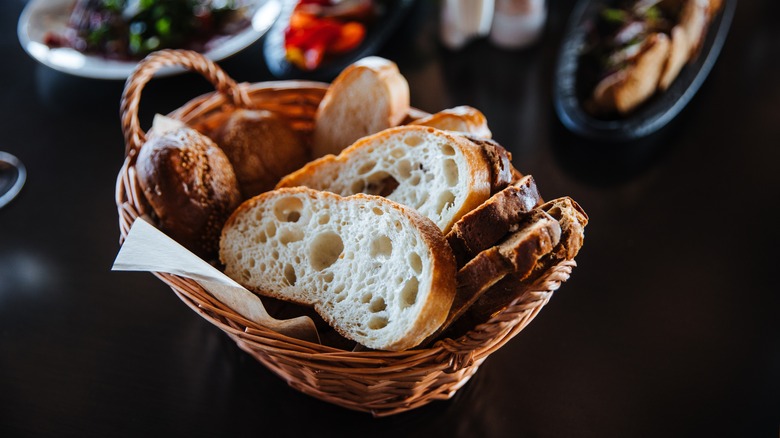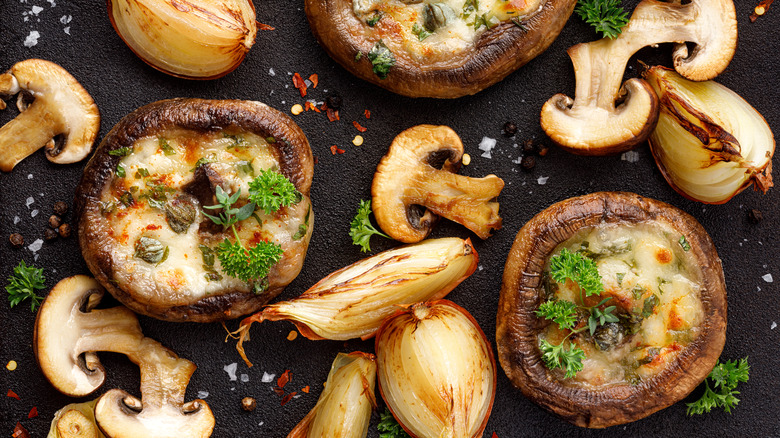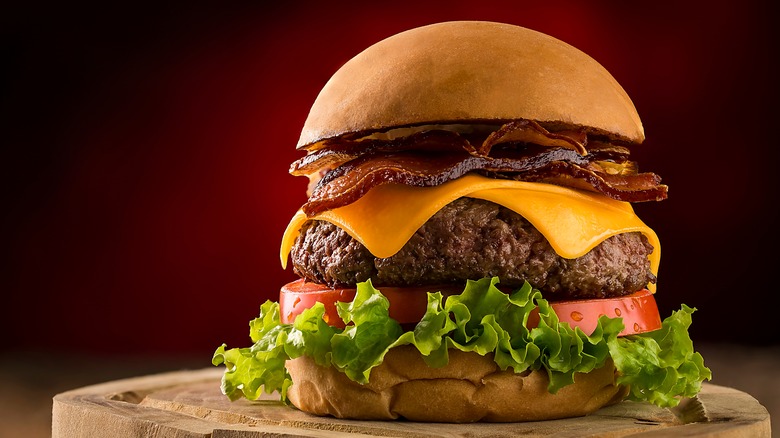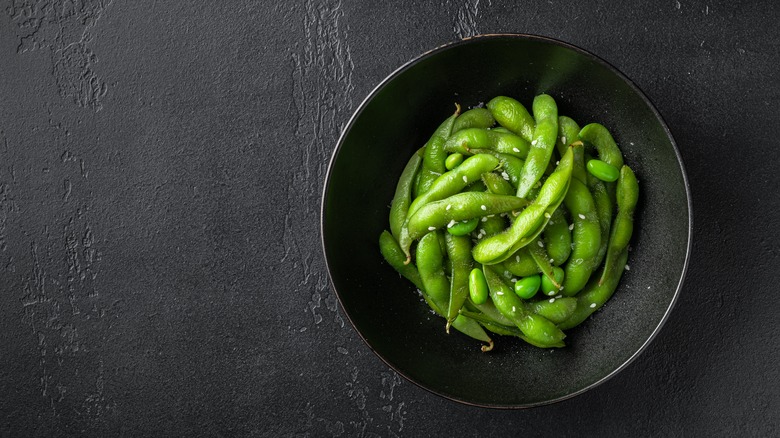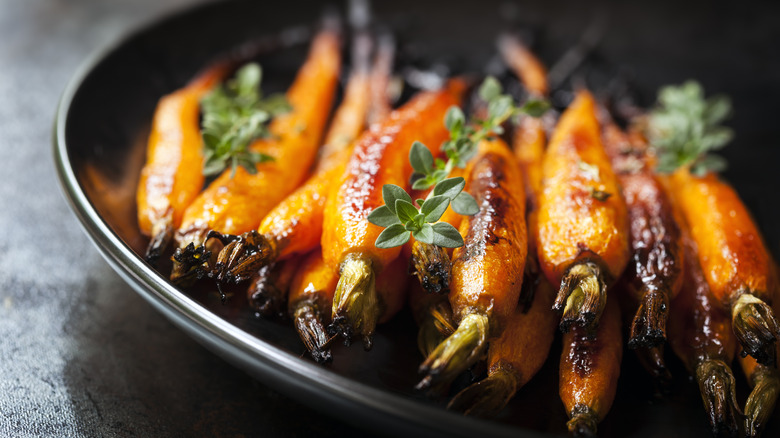15 Overpriced Foods You Should Never Order At Restaurants
Everyone knows it: The cost of eating at restaurants is too darn high! And, with the price of dining out only rising day by day, it may be time to examine what's really worth the blow to your wallet when it comes to the menu. Be honest — have you ever experienced sticker shock while perusing a selection of appetizers? Maybe you ran through some quick mental math to try and calculate just how much of a markup you're about to pay for a plate that should cost less than half of the asking price — and that's not including a tip.
Most restaurant dishes are absolutely worth shelling out the big bucks for, especially the ones that are difficult to replicate at home or require a skill set/time you simply don't have. But if the menu item in question is comprised of inexpensive ingredients, requires little practice to master, and takes only a small amount of effort and/or time to make, then there's no reason to pay a 350% markup for it.
So, what are the most overpriced foods you should never order at restaurants, and how can you learn to make them at home? It's time to find out!
1. Shishito peppers
Blistered shishito peppers are an increasingly popular veggie for foodie fanatics and casual culinary connoisseurs alike. This pepper's popularity is well-earned — after all, it's downright delicious, fun to eat, and healthy, too. It almost sounds too good to be true, which is probably why restaurants charge so much for them.
Making blistered shishito peppers that taste as good as any restaurant's version is easy — so easy, in fact, it's hard to justify paying someone to make them for you. Simply visit a local grocer or a farmer's market when shishito peppers are in season, which will be from summer to early fall. Fresh is always best when it comes to simple recipes like this one, so it's essential to get your hands on high-quality shishito peppers. With so few ingredients, every element has to hold its own.
To cook the peppers, get a pan, cast iron skillet, or wok to a rippingly hot temperature and add a small amount of high smoking point cooking oil (duck fat is incredible for this). Toss in the peppers, let them blister for a few minutes (or until they reach the desired level of char), then turn off the heat, remove the peppers to a bowl, toss them with salt, and serve immediately with whatever dipping sauce you want. But be warned: Every once in a while, a mind-numbingly spicy shishito sneaks its way into a batch of peppers.
2. Sauces
From ketchup to aioli, the cost of sauce is far too high. That's right, someone finally said it. Since when did it become acceptable, much less the norm, for restaurants to charge extra for the dipping sauce that naturally accompanies the dish you ordered? Suddenly, you're spending a sneaky 50 cents here and 25 cents there to have ketchup with your already overpriced fries, or tartar sauce with your $20 fish and chips. Imagine it's brunchtime, someone at the table orders an eggs benedict, and the waiter asks, "Would you like to add hollandaise to your dish for just a dollar extra?" It simply doesn't make sense.
But what does make sense is turning this outrageous cost of sauce crisis into an opportunity to explore sauces and dips galore. And the best place to start with that is the five mother sauces of French cuisine. Afterward, everything is possible, from beer-cheese dip to a spot-on imitation of In-N-Out's secret sauce.
3. Blackened Brussels sprouts
Brussels sprouts are an inexpensive ingredient, and the fire that's used to char them up shouldn't cost all that much either. So what exactly are chefs doing to these veggies behind closed doors, and how can it possibly justify a plate of blackened Brussels sprouts costing much more than the sum of its parts?
Whether roasted, toasted, broiled, or baked, Brussels sprouts are at their best when they've been kissed by flames and are a little (or a lot) burned. The charring process adds much-needed flavor and texture, turning what could have been a disappointing Brussels sprout experience into one to write home about. But what's the secret Brussels sprout roasting tip that restaurants use to keep customers coming back time and time again, just to spend $12 on what can be made (often better) at home for half the price?
The answer is as simple as remembering two things — firstly, start the recipe by cooking up some bacon, guanciale, or pancetta. Remove the crispy pork to the side and use the rendered fat as cooking oil for the Brussels sprouts. When the dish is crisp, turn off the heat, return the pork to the pan, et voila: flavor! Secondly, and most importantly, don't be afraid to really char the sprouts. High heat may seem intimidating to handle, but it's how restaurants transform an inexpensive vegetable into a dinnertime delight.
4. Shrimp cocktail
Shrimp cocktails are perhaps the most socially-acceptable finger food in the restaurant industry, and they're certainly among the most fun to eat! Indeed, there's something incredibly satisfying about seeing all those plump pink shrimp, perfectly perched around the rim of a glass that's been filled to the brim with the quintessential cocktail sauce.
But somehow, knowing exactly what goes into making this seemingly complex sauce, the backbone of the shrimp cocktail, can have you questioning why you're shelling out so much for this shellfish dish. So, what's in the classic shrimp cocktail sauce? Hold the drumroll please — it's ketchup, horseradish, Worcestershire sauce, sugar, and a little bit of lemon. This recipe begs the question: How does a restaurant charge anywhere from $12 to well over $20 for a few shrimp served with what is, quite frankly, decked-out ketchup? The next time a shrimp cocktail craving rears its head, try making it at home instead.
5. Blooming onion
A blooming onion is bloomin' delicious, so please don't misunderstand us ... but how does this vegetable, quite literally one of the most affordable ingredients in today's food market, go from costing close to zero to being a heroically hefty menu item so fast? Can a few fancy twists of a knife and a deep fry really elevate the humble onion to cost the same as an entire deli sandwich?
To make a blooming onion at home, simply acquire an onion (yellow or white), cut off the tip, and peel. Trim the onion's roots but keep them intact. Then flip the onion root-side up and cut even slices, using the root as an epicenter to guide the knife. Once the knifework is done, spread the "petals" of the blooming onion, toss it in some seasoned flour, dip it in an egg wash, toss it once more in flour, then fry until crispy and serve hot with a dip. For another festive fried onion flavor profile, give fried spring onions a shot.
6. Wedge salad
Wedge salads are, in many ways, an iconic all-American restaurant staple. And for good reason — what's not to love about a crisp quartered head of iceberg lettuce, topped with simply sumptuous bleu cheese dressing, crispy savory bacon, salt, pepper, and possibly a few tomatoes and some chives to garnish? Well, the only part that's hard to love is the ever-climbing cost of what should be an inexpensive menu item. After all, it's just a salad — and one the kitchen doesn't even have to cut up before serving.
There are a million and one renditions of this dish, which makes mastering an amazing modern wedge salad recipe as easy as cake (a lot easier than cake, actually, and a whole lot healthier). This salad is an excellent addition to any meal plan, especially going into spring and summer when the heat makes cooking sound ... well, hot. So just chill a plate in the freezer, quarter off a wedge of iceberg, and deck it out with all the fixings.
7. Baked potato
The humble baked potato is just that: humble. No frills, no fru-fru, and certainly no fluff go into its preparation. Unlike this dish's more complicated cousin, the twice-baked potato, there is nothing pretentious about a potato that's been cooked up and served hot (slathered in butter, of course). So, how is it that restaurants continue to try and succeed in charging their customers so much for this simple root vegetable?
With just a few baked potato tips and tricks, even the least practiced home cook can produce splendidly-baked spuds 10 times out of 10 — which is funny, considering 10 out of 10 is also the rating your savings account gives to homemade baked potatoes.
As for the extra toppings that make baked potatoes so good, don't worry. Now is the perfect time to explore the boundaries of what a baked potato can really do. From the classic butter, bacon, sour cream, and chives to a chili cheese baked potato, all the way to Idaho's ice cream baked potato, the possibilities are only limited by your imagination. And that's more than you can say for those pricey baked potatoes from restaurants.
8. Casual cocktails
There's nothing wrong with a cocktail (or two) with brunch, lunch, or dinner, but there's a fine line between having a bit of frugal fun and downright fiscal irresponsibility. And, when it comes to cocktails, drinking more than one can really add up. In fact, the simple act of indulging in just a few drinks at a restaurant can more than double the cost of your meal on the town.
It's a tale as old as time — you decide to eat out at a nice new restaurant and treat yourself to a cocktail. The drink comes and goes right down the hatch and, before you know it, you're three $14 lemon drops into an incredibly expensive buzz. The inhibition-lowering effects of alcohol, which can work wonders in social situations or when one is in need of a little liquid courage on a first date, can also lower your fiscal inhibitions.
And it's a shame to spend so much on drinks, especially because it's so easy to make amazing cocktails in the comfort of your own home. Sure, the startup cost of cocktail ingredients can be intimidating — but that intimidation disappears when you realize you can now make 30 drinks for the same price as the three drinks you had in one sitting at a restaurant.
9. Chips and salsa
There was a time, not very long ago, when eating out at the local Mexican restaurant required some amount of restraint. Why? Well, because it was all too common to ruin your appetite gorging on all those complimentary chips and salsa for the table. But somehow, the price of chips and the accompanying spicy dips has risen exponentially in the past few years and what was once free now costs a seemingly exorbitant fee. At this point, the must-have mark of a good Mexican restaurant is a serve-yourself salsa bar, complete with radishes, pickled jalapenos, and a pile of limes.
But if you're being asked to fork over 5-plus dollars for some deep-fried tortillas and salsa, then it may be time to consider learning to make that salsa at home. With the internet and all its wisdom at your fingertips, there's no way to go wrong. So, set out to beat the restaurant chips and dip fee and explore the world wide web and all its salsa recipes.
10. Side of rice
This trick with rice will revolutionize your life — or, at the very least, it will make you reconsider spending the restaurant price for a side of rice on those to-go meal kind of days. So many meals are improved by (and even need) rice to bring balance, flavor, texture, substance, and so on. Without a side or rice, many great curries, stir-fries, and other quintessential staple meals from across the globe would fall flat. But, when you're already spending $50-plus on a meal from a restaurant, being charged extra for rice doesn't feel right.
Enter the rice cooker, a piece of kitchen equipment that no person who regularly cooks rice should be without. A rice cooker guarantees fast and affordable rice at any time — perfectly hot, steamy, and ready to accompany any (or all) meals! With that, takeaway rice for an extra price will become a thing of the past and the future is filled with the promise of homemade bowls of all different types of rice.
11. Bread for the table
Bread for the table is, in many ways, the ideal centerpiece for a meal — especially served in a basket or bowl and wrapped up in a napkin to keep all that fresh-baked bread warmth trapped inside. More often than not, a basket of bread was a given when eating out at a restaurant; it was complimentary and came with the unspoken promise of an endless supply of refills. But nowadays, ordering bread for the table can set you back a fair few bucks, which can become even more disappointing when the bread in question turns out to be half a loaf of semi-stale something or other.
The same trend goes for naan for Indian takeout, pita to go with a souvlaki plate, or breadsticks and garlic bread to match the pizza delivery ... at this point, it may be time to buckle down and become the baker to someone's butcher and candlestick maker. That is to say, try your hand at making your own bread instead.
12. Stuffed mushrooms
Stuffed mushrooms may not be everyone's favorite dish, but for the fungi fans out there, few (if any) snacks can stack up next to a stuffed, baked, and sometimes sauced mushroom. At a restaurant, this dish can easily hit the double digits when it comes to dollar signs. But the ingredients involved in making stuffed mushrooms are so simple: mushrooms, breading, sausage, and optional sauce on top, plus a few other accouterments. Why then, do they cost an arm and a leg on any appetizer menu?
There are better ways to spend hard-earned money than on a dish that can be made at home for less than half the restaurant cost — all you need in a simple stuffed mushroom recipe, a will, and a way to hold yourself back from making these delicious bites over and over again for breakfast, lunch, and dinner every day of the week.
13. Add-ons
"Would you like to add some bacon or a scoop of guacamole for a small extra charge?" This is how restaurants rake in profits, and customers who just wanted an egg on their burger are suddenly (and perhaps without fully comprehending the absurdity of the transaction) spending $2 for a single egg. A tiny scoop of guacamole? That'll be an extra $1.50. Bacon too? That'll be another $2! Suddenly, a $12 burger turns into a $20 charge and you're left contemplating whether or not the augmentations and additions were worth their weight in (metaphorical) gold.
The price of add-ons on restaurant menus has gotten so bad, it almost warrants a BYOB policy — bring your own bacon, that is to say. Rather than paying by the half-slice, put the money toward a bacon press, and learn to fry perfect bacon at home. And if you order in, you can add it to a takeout burger yourself.
14. Edamame
Edamame is usually one of the more affordable appetizers, which may make them seem as though the restaurant selling the dish isn't significantly overcharging. But that isn't necessarily true. For the same cost as a single small bowl of edamame at a restaurant, you can buy a pound of edamame for your kitchen at home. Yes, the edamame served at restaurants has a delicious flavor that may seem hard to make at home, but making restaurant-quality edamame actually an incredibly simple process, especially if you have an edamame recipe to work from.
Simply sear the edamame, shell on, in a hot pan with a high smoking point cooking oil. Once they are heated through and have an almost nutty, toasty scent, toss in some sesame oil, garlic granules, and salt and you'll have an unbeatable edamame snack to eat any time your heart desires. Serve as a snack or as a side to a meal — just don't shell out the big bucks buying these beans from a restaurant.
15. Honey-glazed carrots
There's nothing quite as delicious as a properly oven-charred honey-glazed carrot. When given the proper respect and roast they deserve, these root veggies are so sweet, super syrupy, and just burned enough to keep the palate intrigued. It's a shame that this dish is so criminally overpriced and simultaneously underrated. A small plate of baked carrots at a restaurant can set your bank account back big time, but a carrot itself costs nearly nothing at the grocery store.
That's why honey-glazed carrots are best done at home, in the comfort of one's own kitchen (and budget)! To roast deliciously charred carrots, just wash them, peel, drizzle with a little oil, and pop them onto a tray and into the oven until they've blackened to taste. Remove from the oven and, with the baking sheet still hot, toss the carrots in a honey compound butter and enjoy the sweet taste of victory over overpriced restaurant foods.
